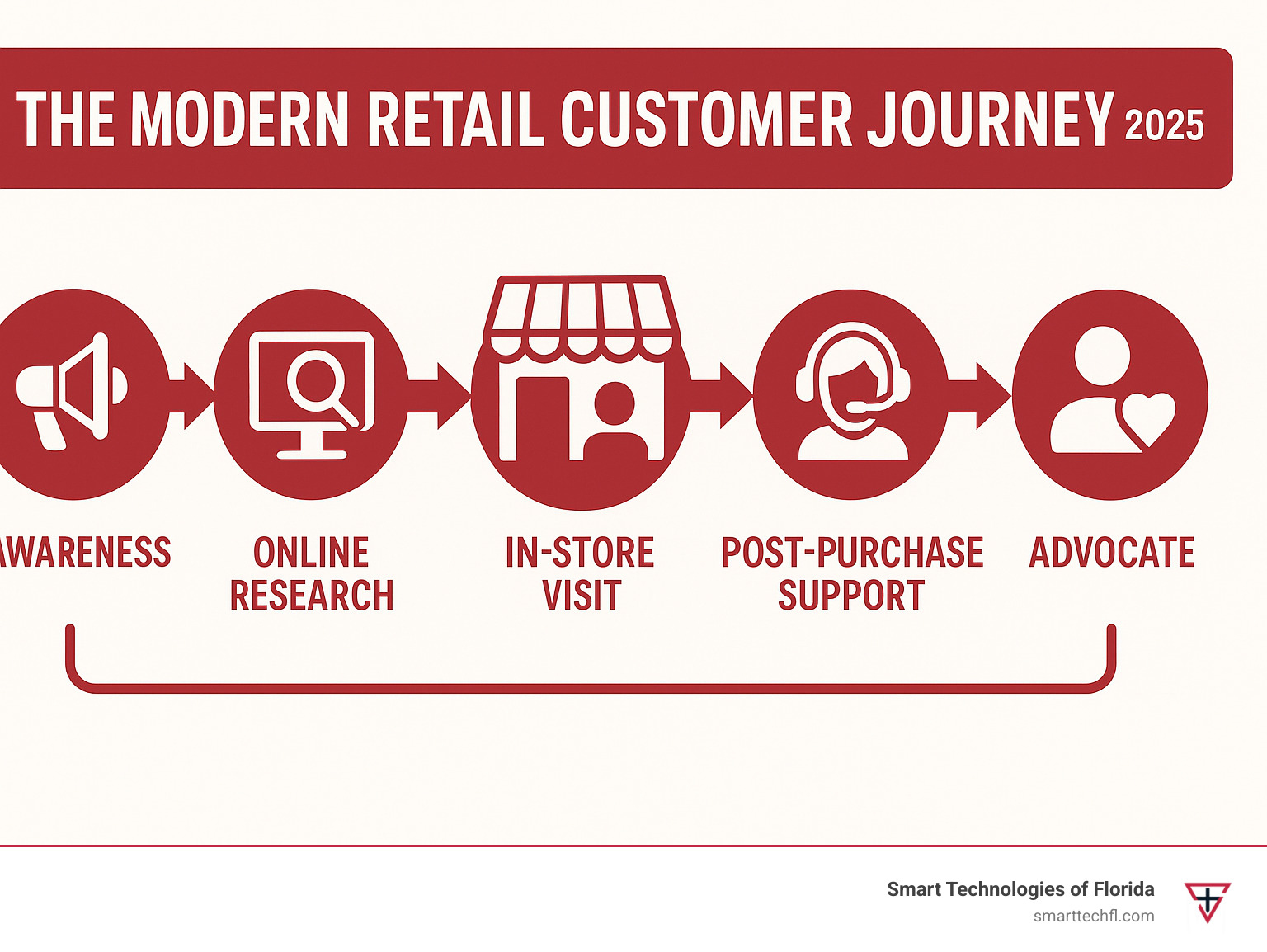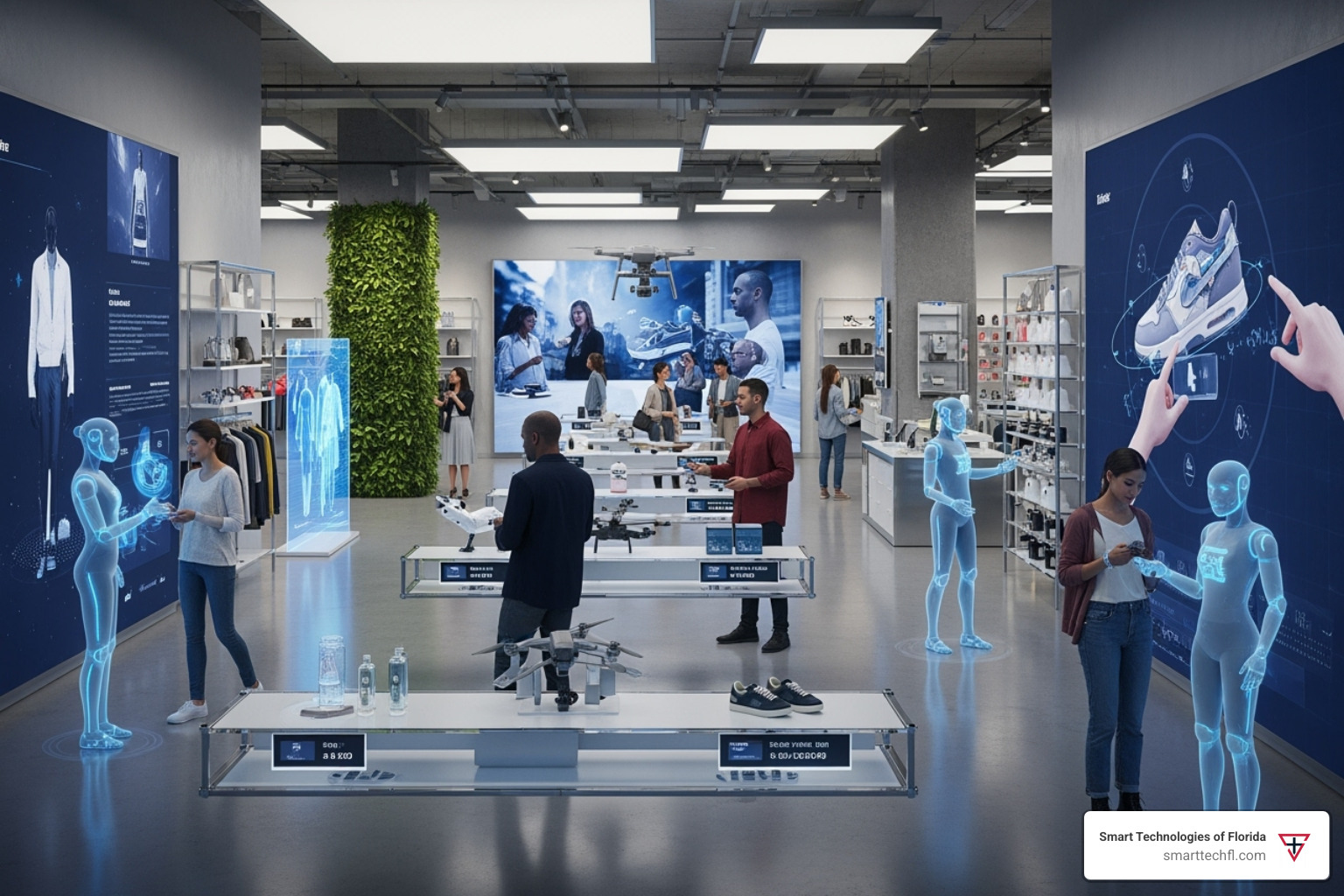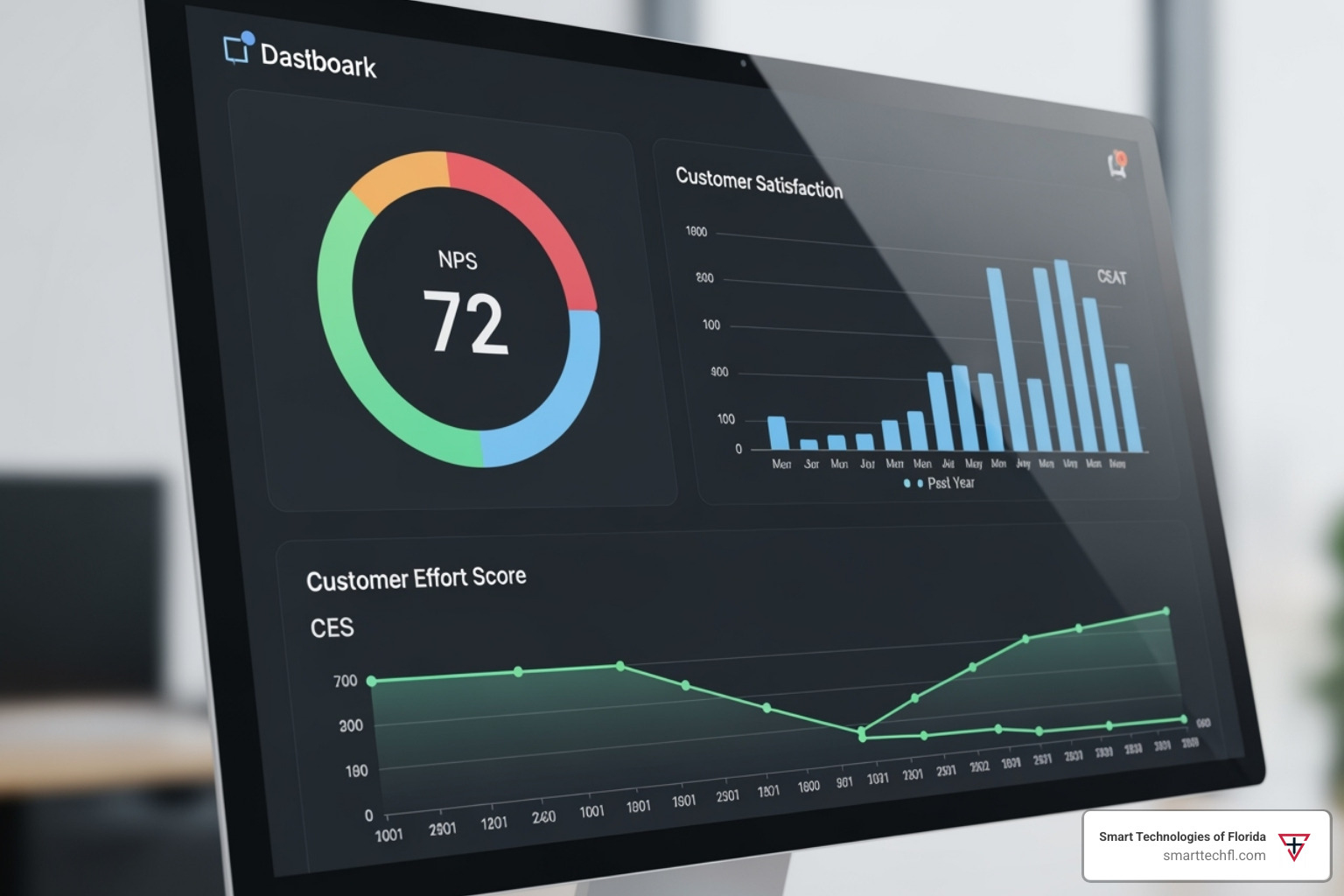Retail Therapy: How to Enhance Customer Experience in Stores
Improving the retail customer experience isn’t just about making shoppers happier—it’s a direct investment in your bottom line. Companies that excel in customer experience (CX) see revenue growth 4-8% higher than their competitors. Furthermore, customers who have a top-tier experience spend 140% more and remain loyal for up to six years.
Quick ways to improve retail customer experience:
- Train staff to be knowledgeable product experts who use positive language
- Optimize store layout with clear signage and intuitive product placement
- Reduce checkout friction with mobile POS systems and multiple payment options
- Create omnichannel consistency between online and in-store experiences
- Personalize interactions using customer data and purchase history
- Gather feedback regularly through surveys and act on customer insights
The stakes are high: one in three customers will leave a beloved brand after a single bad experience. Since 91% of unhappy customers leave without a word, you might be losing business without realizing it.
Retail CX covers every interaction with your brand, from online findy to post-purchase support. It’s what turns a one-time buyer into a lifelong advocate. Meaningful improvements don’t require a massive budget; small, consistent changes can make all the difference.

Understanding the Modern Retail Customer Experience
The modern customer journey is complex, spanning social media, websites, physical stores, and post-purchase support. Each touchpoint shapes their perception of your business. Retail customer experience (CX) encompasses every emotion and interaction a customer has with your brand, from initial awareness to long-term loyalty.
In a market where products and prices are often similar, a superior customer experience is the ultimate competitive advantage. It’s how you make people feel that sets you apart. Companies that master CX see revenues jump 4-8% over competitors, and customers who rate their experience a 10/10 spend 140% more and stay loyal for up to six years. A 2018 PwC study on the value of experience found that 58% of customers will pay more for better service.
The rise of e-commerce has revolutionized customer expectations. Shoppers now demand a seamless omnichannel experience, moving effortlessly between online and in-store channels. While US e-commerce sales continue to surge, physical retail still accounts for nearly 80% of global sales, highlighting the need for a hybrid strategy.
The financial stakes are immense. Poor customer service leads to over $62 billion in lost revenue annually, with 91% of unhappy customers leaving without complaint. Conversely, 71% of people will recommend a brand after a great experience, providing powerful, organic marketing.
Customer Service vs. Customer Experience
It’s common to confuse customer service with customer experience, but they are distinct concepts that work together.
| Feature | Customer Service | Customer Experience (CX) |
|---|---|---|
| Scope | Reactive, single touchpoint, specific interaction | Proactive, entire customer journey, all interactions |
| Focus | Problem-focused, resolving immediate issues | Relationship-focused, building long-term loyalty |
| Timing | Occurs when a customer needs help or has a query | Continuous, before, during, and after a purchase |
| Goal | Resolve issue, answer question, provide support | Create positive emotions, build brand connection, satisfy needs |
| Ownership | Often a specific department (e.g., support team) | The responsibility of the entire organization |
| Metrics | Response time, resolution rate, customer satisfaction (CSAT) for that interaction | NPS, CSAT (overall), CES, customer retention, lifetime value |
Think of customer service as a single chapter, while customer experience is the entire book. A quick return (good service) can’t fix a confusing website or misleading product info (bad experience). While excellent service is a crucial safety net, a truly great CX requires every department and touchpoint to work in harmony.
The Financial Impact of CX
Investing in CX is a smart financial strategy. Customers with great experiences spend 140% more and stay loyal for up to six years, a stark contrast to the high cost of new customer acquisition.
Conversely, one bad experience can cause one in three customers to leave a brand forever. Since 93% of consumers read online reviews, a single negative event can have a widespread impact on your reputation.
A positive CX creates a flywheel effect: satisfied customers become brand advocates, driving word-of-mouth marketing and offering more forgiveness for minor issues. Today, over 80% of companies compete primarily on customer experience, making it essential for survival and growth.
Strategies to Lift the In-Store Experience
Despite the growth of e-commerce, physical stores will still account for nearly 80% of global retail sales in 2025, making the in-store experience paramount. Your store should be a destination, not just a place for transactions.

Your team is the heart of this experience. Empowered and knowledgeable staff can transform a simple shopping trip into a memorable event. This requires comprehensive employee training in both product expertise and people skills. When staff can solve problems on the spot using positive language, customers feel valued. Happy employees are also 12% more productive, and their positive energy is palpable.
Experiential retail turns shopping into entertainment by allowing customers to engage with your brand through in-store events and workshops. For example, Jordan’s Furniture created a destination with attractions like ropes courses and theaters, turning furniture shopping into a family outing.
Your store environment and merchandising also play a crucial role. An intuitive store layout, proper ambiance (lighting, scent, music), and clean, visually engaging curated product offerings create a welcoming atmosphere before a single word is spoken.
Frictionless Checkout and Returns
Long checkout lines are a major pain point; shoppers will abandon a queue after just nine minutes, and 86% avoid stores known for long waits. Reducing wait times is a quick win for CX. Implementing Mobile POS systems and accepting digital wallets can significantly speed up the process. In fact, 51% of consumers expect digital payment options.
Similarly, easy return policies are a powerful sales driver. While returns can be costly, 98% of customers will make a repeat purchase if the return process is hassle-free. Smart retailers view returns as an opportunity to bring customers back into the store. As research shows, a convenient return process is so valuable that customers are often willing to pay for premium return services. The goal is to make every transaction smooth, keeping the focus on the products, not the process.
How to Improve Retail Customer Experience Across All Channels
Modern customers expect convenience and move fluidly between online and in-store channels. A seamless experience across all touchpoints is no longer optional.
Your website and mobile optimization is the digital front door. With nearly 60% of buyers prioritizing mobile shopping options, a slow or clunky mobile site is a major deterrent. According to Deloitte’s research on mobile site speed, even a 0.1% improvement in mobile site speed can boost conversions by 8%. Your site must have intuitive navigation, fast loading times, and a frictionless checkout.
Seamless omnichannel integration is a business necessity. 73% of shoppers use multiple channels, and these omnichannel customers are more valuable, spending more and showing greater loyalty. Services like Buy Online, Pick-up In-Store (BOPIS) are projected to exceed $200 billion in sales by 2028. True integration means creating unified customer profiles and ensuring consistency in pricing, promotions, and service across all channels to build trust.
How personalization can improve retail customer experience
Thoughtful personalization makes customers feel understood and has a remarkable impact: 80% of customers are more likely to buy from brands that offer personalized experiences, which can increase basket size by 30%. Beyond data, the goal is building emotional connections. Over half of the customer experience is based on emotion, and businesses that foster these connections outperform competitors by 85% in sales growth. This can be as simple as remembering a regular’s preferences or sending a thank-you note. Effective personalization uses customer data to provide relevant recommendations while creating authentic, human connections through surprise and delight moments that build lasting loyalty.
Leveraging Technology for Improvement
Technology is revolutionizing customer connections, with significant investment in AI. According to Gartner’s latest survey, executive budgets for generative AI are expected to increase by 34% in 2025, with AI overall growing by 33%.
- AI-powered chatbots provide instant 24/7 support for common queries, freeing up human staff for more complex, empathy-driven problem-solving.
- Augmented Reality (AR) helps customers visualize products in their own space, like trying on clothes or placing furniture, which boosts confidence and reduces returns. Sephora’s “Virtual Artist” is a prime example.
- Virtual Reality (VR) offers immersive experiences like virtual store tours or product simulations, creating unique brand interactions.
The key is to use technology to improve human connection, not replace it. Thoughtfully implemented tools streamline operations, offer deep insights, and create more engaging and efficient shopping experiences.

Measuring Success and Acting on Feedback
If you’re not measuring customer experience, you’re just guessing. To genuinely improve retail customer experience, you must track performance and turn feedback into actionable insights.

Think of these key CX metrics as your business’s vital signs:
- Net Promoter Score (NPS): Asks “How likely are you to recommend us?” to measure overall loyalty and advocacy.
- Customer Satisfaction (CSAT) Score: Measures happiness with a specific interaction, helping pinpoint strengths and weaknesses.
- Customer Effort Score (CES): Asks “How easy was it to handle your request?” to gauge friction in the customer journey. As noted in a Forbes article on CX metrics, these measurements provide a complete view of customer sentiment.
To understand the ‘why’ behind the scores, gather customer feedback through various channels:
- Surveys: Use brief post-interaction surveys via email or SMS.
- In-Store Feedback: Use simple terminals for quick input.
- Social Media Listening: Monitor platforms for unfiltered opinions.
- Online Reviews: Actively monitor and respond to reviews, as 93% of consumers read them before purchasing.
The most critical step is closing the feedback loop: analyze insights, make changes, and communicate those changes back to your customers. This shows you value their input and turns them into loyal advocates.
Addressing common pain points to improve retail customer experience
Frequently Asked Questions about Improving Retail Customer Experience
What is the main difference between customer service and customer experience?
Customer service is a single, reactive interaction, like handling a return or answering a question. It’s one piece of the puzzle. Customer experience (CX) is the entire journey and the customer’s overall perception of your brand. It includes every touchpoint, from your website’s usability to the in-store atmosphere and post-purchase support. In short, service is a moment; experience is the entire relationship.
How can a small retail business start improving its customer experience?
You don’t need a large budget to improve retail customer experience. Start with these simple steps:
- Gather feedback: Ask customers for their opinions at checkout or through simple surveys to identify pain points.
- Train your team: Invest in training staff to be friendly, knowledgeable, and empowered to help customers. Their positive energy is a key asset.
- Ensure consistency: Make sure your basic information, like store hours and pricing, is accurate and consistent across all online and in-store channels.
- Focus on the details: A clean store, clear signage, and small, thoughtful touches show customers you care and can significantly improve their visit.
What role does technology play in the future of retail CX?
Technology’s role is to amplify the human touch, not replace it. It helps retailers understand and serve customers on a deeper level.
- AI and data analytics enable hyper-personalization, allowing you to offer custom recommendations and services based on individual shopping patterns.
- Augmented Reality (AR) offers powerful “try before you buy” experiences, letting customers visualize products in their own environment, which boosts confidence and reduces returns.
- Predictive analytics helps forecast customer needs, allowing for proactive inventory management and timely promotions.
Technology should free up human staff to handle complex issues and build genuine relationships, blending efficiency with a personal connection.
Conclusion: Changing Your Business with a People-Centric Approach
To improve retail customer experience is to fundamentally change your business with a people-first mindset. CX is a holistic strategy, not a single initiative. The rewards are clear: significant revenue growth and customers who spend more and stay loyal longer.
The new currency of trust is consistency across channels. Customers expect a seamless, unified journey whether they are online or in-store. Every touchpoint must work in harmony to deliver the same high level of care.
Technology should enable personalization and efficiency, making interactions easier and more delightful, not more complicated. Most importantly, measuring and acting on feedback is what fuels continuous improvement. Listening to customers and closing the feedback loop builds a community of valued advocates.
A superior customer experience is a core business driver. It turns buyers into loyal fans and satisfied shoppers into your best marketers.
At Smart Technologies of Florida, our 23 years of experience are built on a people-centric approach. We help businesses use digital solutions to serve their customers authentically and achieve their unique goals.
Ready to transform your customer experience? Our digital change services can help you build the meaningful connections that drive lasting success.












